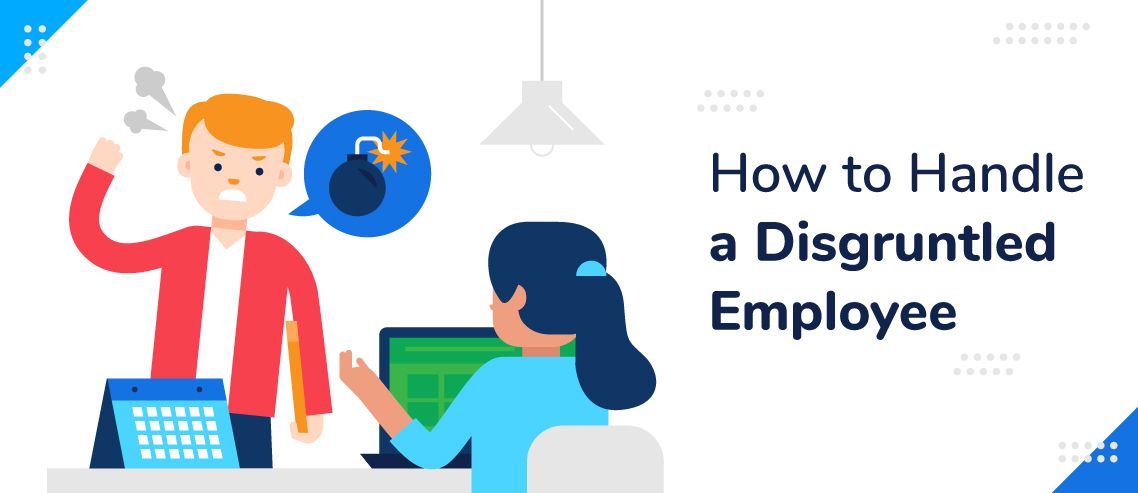How To Deal With A Difficult Employee and Succeed in 2024

Dealing with a difficult employee is always a challenge. You will likely have to deal with one in the course of your career. With the expansion of remote work and hybrid remote work, you may face unique challenges when dealing with difficult people.
These problematic employees affect your energy, motivation, and focus, along with the rest of the team. That’s why it’s so crucial to address any issues outright, without hesitation.
Whether you run a small business or a Fortune 500 company, knowing how to quickly handle difficult team members will save you time, raise productivity, and improve your work environment.
Let’s explore what a difficult employee looks like, as well as tactics to deal with them.
What Is A Difficult Employee?
Difficult employees are a headache for any organization. They often exhibit certain tendencies of bad behavior that become toxic to others around them.
Let’s look at some specific examples of difficult employee behavior:
1. Undermine your authority
One of the biggest red flags of an employee’s behavior is undermining authority. This is when an employee either directly or indirectly disobeys the chain of command within the company.
For instance, the problem employee may refuse to respect their direct supervisor’s requests. They may even try to justify their behavior by saying things like “You’re not my supervisor!”
Many companies today are “flat” so there is not a traditional hierarchy. However, there is also some kind of rank or authority, otherwise, it would be impossible to hold anyone accountable.
2. Bad attitude
A bad attitude is when the employee exhibits a lack of urgency, lack of optimism, or other forms of negativity. The reality is that a bad attitude can turn into a performance issue fast.
As an example, imagine an employee who constantly says negative things to their coworkers throughout the day. When their manager asks them to participate in a team meeting, they sigh loudly and make their way to the conference room as slowly as possible.
This type of problematic behavior doesn’t just affect themselves, but everyone around them — decreasing overall productivity.
3. Toxic behavior
Toxic behavior is one step worse than merely a negative attitude. Toxic behavior involves negative words, actions, and outcomes for all those involved.
Just like a virus, this employee infects all of those around them and it takes time to rid yourself of the consequences of their negative behavior.
An example of toxic behavior is creating unnecessary conflict within the company. Imagine a salesperson who constantly blames the marketing department for the quality of leads coming in.
The toxic person may even resort to language, name-calling, gas-lighting, and public humiliation. All the while, they avoid reasonable conversations in private or searching for a solution.
4. Not completing work
Not completing work is exactly what it sounds like — the employee does not perform their job duties.
This means you have someone on your payroll with poor performance, who is draining company resources while providing nothing in return.
Business owners need to know how this kind of challenging employee operates. There is a simple example of an employee failing to perform an obvious task, such as delivering a mockup of a new logo.
That’s why using time tracking software like ZoomShift is so effective. You can see exactly how many hours employees are working or not working.
How To Manage A Difficult Employee
Now you know what a difficult employee is and the types of traits they have. But those are simply the first steps.
More importantly, you need to understand how to confront the employee and resolve the situation. So let’s talk about key solutions for managing problem employees in any workforce:
1. Identify the Cause of the Problem
Make sure to get to the root cause of the issue. Does the difficult employee have problems in their personal life? Or perhaps they have issues with a fellow employee and feel unheard by human resources.
For example, you may chat with a team member and find out that they feel underpaid. Whether or not they are is another issue, but now you have the culprit in plain sight and you can start to find solutions.
Or the root cause of the problem could be more simple. Perhaps their shift is in the mornings but they prefer to work at night.
If that’s the case, you can use shift swapping software for your team — allowing employees to trade times with one another and enjoy the schedule that fits their needs.
2. Critique Behavior
The employee needs to hear feedback on the negative behavior they are displaying. Only then can you get on the same page and create solutions, such as beginning an employee assistance program or improvement plan.
However, be sure to frame your critique in a way that focuses on the bad behavior and not the person’s identity.
For instance, don’t say “Charlie, you’re slow.” Instead, detach the behavior from the person: “Charlie, speed is of the essence because that’s what our customers pay us for. How can we help you work faster?”
3. Give Clear Instructions
Leave nothing to doubt. Remove any excuses for bad employee performance that could arise from unclear instructions. This may involve difficult conversations, but you need to prevent the negative impact from continuing by outlining exact job instructions, step by step.
For instance, look at the difference between these two sets of instructions for a barista opening up a coffee shop in the morning:
Version A:
- Unlock the doors
- Set up the espresso machine
- Clean the tables
Version B:
- Use key #4 (pictured on page 11 of the manual) to unlock the front door only
- Take a dry clean yellow towel (NOT a blue one, which is for the bathrooms) and wipe the espresso machine down, starting with the nozzle.
- Use the cleaning mixture labeled “ESP” and spray it on the machine.
Notice the difference in detail between the two sets of instructions? What seems like “common sense” to you may be completely foreign to an inexperienced employee. So always err on the side of providing instructions that are too detailed instead of the other way around.
4. Set Clear Expectations
In addition to clear instructions, you need to create clear expectations. These expectations are the outcomes of the employee’s efforts that must be achieved.
For instance, you may train your customer service team on how to answer an email inquiry in great detail. However, you must also lay out clear expectations of performance indicators.
These clear expectations help your team perform highly while bringing attention to employees who aren’t stacking up to the challenge.
For instance, in the realm of customer service roles you may have expectations like:
- Answer all inquiries within 24 hours
- Do not close a conversation with a customer until they express that their issue is resolved
- Maintain a satisfaction score of 4 out of 5 stars or higher
These help you hold your team accountable for results, instead of you being manipulated by emotions or favoritism.
5. Provide Clear Consequences
The bottom line is that you must have clear consequences for employees who are being difficult. If there is no disciplinary action tied to poor attitude or performance, then certain employees will take advantage of your leniency. Allow your HR department to help you craft a plan of attack.
Many times, difficult team members continue to act up because they almost feel invincible. Perhaps up until now in your company or other companies, no one held them accountable with consequences.
So make sure that you detail exactly what will happen if the employee continues to cause difficulty. For instance, if “John” shows up late to work, he will be put on unpaid leave. If it happens two more times, he will be fired.
Only you can decide which consequences are appropriate. But the most important takeaway is to have exact disciplinary actions documented. This is usually enough to correct the behavior.
6. Open to Feedback
Part of your company culture should be to accept feedback gracefully. By doing this, you can ensure that employees come to you with issues that may make them upset.
This open feedback policy even works with personal issues. For instance, a difficult employee may come clean and admit that they’re having issues at home with their family.
Since they felt they could be vulnerable with you, you can work together towards a solution such as a few days or weeks to settle their matters. That way, they come back to work ready to perform.
7. Follow Progress
Once you have uncovered the reason for the problem and created a solution, it’s time to engage in a good follow-up. Check in with the employee periodically to ensure their difficulties are no longer prominent.
For instance, you might create a 30-day personal improvement plan for a salesperson who is not hitting their quotas. If they haven’t made progress at the end of the period, then you can take action on your predetermined discipline or help them correct the course.
8. Pre-plan to Prevent
Once you have “handled” the difficult employee, your job is not done yet. The fact is that the team members could go back to their old ways, especially if they don’t feel heard or seen.
To prevent this from happening, have a plan in place to mitigate future issues. Remain open to your employee’s feedback (even non-verbal body language that may indicate dissatisfaction).
If you see telltale signs — being rude, not doing their work, showing up with a bad attitude, etc. — then address it right then and there to prevent difficulties from surfacing again.
How To Give Feedback To Difficult Employees
Never avoid giving feedback to employees just because you are concerned about how they will react. Instead, use these strategies to communicate with them and resolve the problem effectively:
1. Employee is Upset
Angry people often react differently than calm, happy people. The last thing you want to do is add more to the fire by becoming upset yourself. This could result in defensiveness.
Instead, approach an upset employee with kindness and understanding. Use a calm tone of voice (or word choice if you’re communicating in writing).
Ask them why they are upset. If it is work-related, talk through potential solutions and avoid antagonizing them during the discussions.
2. Employee is Uncomfortable
If someone is uncomfortable, it will affect their mindset and their productivity. It could also affect their relationship with their coworkers.
The most important factor when approaching a difficult employee who is feeling uncomfortable is to avoid judging. Everyone has different things that make them uncomfortable.
For instance, there may be an employee who never participates in meetings or speaks about their department’s progress. But by simply asking “What’s bothering you?” you may find out that the employee is nervous when talking in front of others, and it has nothing to do with malice.
3. Employee is Rebellious
Sometimes, you have a rebellious employee who simply doesn’t want to listen to any authority figure. Every time you try to address the issue, it results in defensiveness.
If it is a lingering problem and not a one-time thing, you may need to take more drastic measures.
Be very direct in explaining that the company policies allow for disciplinary action if team members do not respect their supervisors.
Try to uncover what is causing this person to be rebellious. It could be as simple as their manager condescendingly speaking to them.
On the other hand, you may discover that the difficult employee simply doesn’t want anyone telling them what to do. In this case, they may not be cut out for team environments.
When Is It Time to Fire A Difficult Employee?
“Hire fast, fire faster” is a popular mantra in the business world. But how do you know you’re firing a bad employee in the right time frame?
Here are some examples of times when it’s okay — and even necessary — to fire someone who is being difficult at work:
- Violence: any form of violence in the workplace is an immediately fireable offense. Make it clear you don’t tolerate it by immediately firing the offender.
- Stealing: unfortunately a small percentage of employees steal from their companies and coworkers. If that happens, let the person go immediately and consider getting law enforcement involved.
- Failure to Improve: if you have addressed the employee’s problematic behavior numerous times to no avail, then it’s probably time to part ways. For instance, if they failed to produce more positive results after being put on a personal improvement plan, then it’s highly unlikely their behavior will change.
- Trading Secrets: if someone has sold or otherwise handed over company secrets of any kind, this can damage your organization immensely. This is highly unacceptable and in many cases, illegal. Do not hesitate to fire this person immediately.
What Is The Cause of A Difficult Employee?
Several potential reasons will cause an employee to be difficult. Here are the most common ones:
- Workload: a high workload is one of the most cited reasons for stress in the workplace, which leads to additional difficulties.
- Lack of Respect: people who don’t feel respected often start disrespecting others in return.
- Feeling Undercompensated: no one wants to feel underpaid, which can cause them to lash out in the workplace.
- Personal Problems: sometimes, an employee’s personal life negatively affects their professional life and relationships.
- Job Security: if someone feels like their employer is not loyal to them, it will often result in a lack of loyalty the other way around.
It’s important to address these 5 sources of difficult employees with sound strategies and tools.
For instance, using a comprehensive team scheduling platform like ZoomShift also allows you to create 1 on 1 or group chats with employees. Therefore, you can maintain communication and root out any problems before they become too large.
Common Questions On How To Deal With A Difficult Employee
1. How do you deal with an employee who undermines you?
First, seek to understand why they are undermining you. From there, you can adjust your behavior or coach them in improving their attitude.
2. How do you deal with a high-performing toxic employee?
It’s best to start with praise for their high performance. Then, transition into the toxic behavior they are displaying and work to eliminate the root of the problem.
3. What is the best way to address toxic behavior?
Begin with empathy and understanding. Once the employee feels you are listening, they will be more open to addressing their toxic behavior.
4. How do you deal with an employee who is causing a lot of conflict in the workplace?
Don’t beat around the bush. Inform the employee that their actions are causing difficulties for others, and request their help in turning things around.
5. What should you do when an employee is struggling with work-life balance?
Some people just need to vent about their problems before resuming normally. Other times, the employee may need time to resolve a serious situation, in which case a temporarily lighter workload or vacation may be best.
6. How do you deal with a toxic employee who is your boss?
Your boss is still a person just like you, so speak honestly with them. Explain exactly what you feel is toxic and ask them if they can behave differently to keep you as a team member.
Difficult Employee Statistics: 73% of respondents quit a job due to a difficult coworker
We asked 868 respondents, who are currently employed, about their experiences with difficult co-workers and toxic work environments. Our survey also looks at the primary reasons people have left their jobs in the past year.
- 72% of respondents said they have quit a job due to a difficult co-worker.
- 73% of respondents have quit their job due to a difficult boss or manager.
- 88% of people have worked in a toxic workplace.
- 81% of respondents said a difficult employee has caused work to be slowed or stopped completely.
We asked respondents what emotions they felt when a manager failed to deal with a difficult employee.
- Sadness
- Fear
- Disgust
- Anger
We found that 68% of respondents have changed jobs in the past year. The primary reason for leaving that job:
- 27% of respondents left for a better salary.
- 21% of respondents left due to a toxic workplace.
- 21% of respondents left due to a difficult coworker.
- 6% of respondents left for better benefits.
- 4% of respondents left for a better career growth path.
Is there a different experience for males and females in the workplace?
Men:
- 74% of male respondents said they have quit a job due to a difficult coworker.
- 74% of male respondents said they have quit a job due to a difficult boss or manager.
- 90% of men have worked in a toxic workplace.
- 70% of male respondents have changed jobs in the past year.
Women:
- 70% of female respondents said they have quit a job due to a difficult coworker.
- 73% of female respondents said they have quit a job due to a difficult boss or manager.
- 87% of women have worked in a toxic workplace.
- 67% of women have changed jobs in the past year.
Which generations have made job changes in the past year?
Over the past year, the job market has exploded with a lot of movement of workers to new jobs.
- 18-24yrs old – 79% of respondents in the age group changed jobs in the past year.
- 25-34yrs old – 70% of respondents in the age group changed jobs in the past year.
- 35-44yrs old – 62% of respondents in the age group changed jobs in the past year.
- 45-54yrs old – 77% of respondents in the age group changed jobs in the past year.
Methodology
We survey 868 people who are currently employed living in the United States of America.
Fair Usage
Zoomshift.com allows sharing of the data points and graphics created and shared on this page. We ask that you provide an attribution link back to our website if you share our study results.
JD enjoys teaching people how to use ZoomShift to save time spent on scheduling. He’s curious, likes learning new things everyday and playing the guitar (although it’s a work in progress).



